Get Your Horse Grooming Groove On ~
Tips from Catskill Horse Magazine Staf
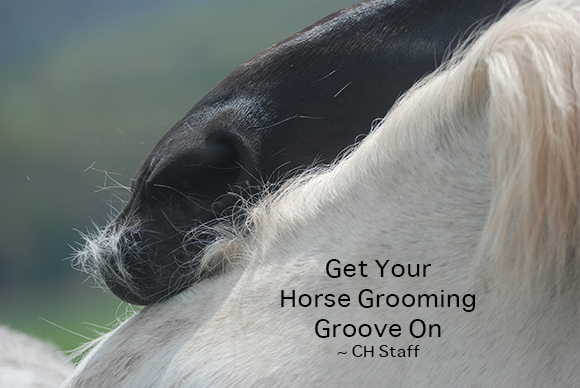
Ready. Shed. Go! Spring has finally arrived and if your horse has enjoyed some winter down time from riding and training, it’s time to beautify your horse with some much needed spa time. Rough winter coats are shedding out, muddy legs and stained tails need attention, and as the temperatures rise bathing becomes an option. Here are a few tips on how to ensure the result of your industrious effort pay off with a sparkling horse. While the skin of the horse is a reflection of inner health that can only be optimized with proper nutrition, there are lots of great spa products that can improve the health of the horse’s skin and coat.
Before bathing groom your horse to remove as much loose hair and dirt as possible using a rubber curry comb, wire infused or union fiber mud brush. As you work around your horse look for any cuts, scrapes or wounds that may need treatment and check for flaky skin or any skin conditions.
Select pH Balanced Shampoo or Washes
Horses have a different skin pH than humans, and to avoid shampoo drying out the equine skin it is important that you select a product that is matched to an optimal pH of 7.0 – 7.4. Human shampoos are more acidic in nature and will therefore dry the skin. When you bath your horse you want to add moisture to its coat, not take it away. While properly formulated horse shampoos may cost more than their cheaper counterparts, their use will always do a better job.
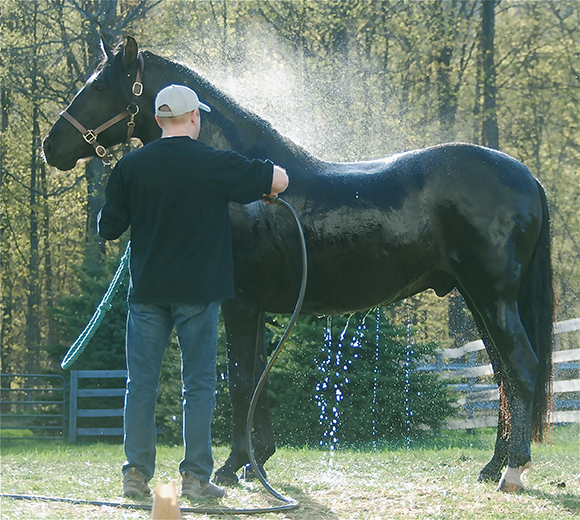
Shampoos that have added provitamins such as B5 will penetrate the hair shaft and add moisture and make the hair appear thicker. Hydrated hair is also less prone to breakage. Glycerin is another valuable component of a well-engineered shampoo product, as it will condition the coat and add shine.
If your horse has any skin conditions or exhibits a flaky or dull coat, use a hygienic shampoo. This doesn’t mean you should reach for an iodine or bleach based product, as both will dry the skin and deplete moisture. Chlorhexidine is a preferred ingredient for disinfecting the horse’s skin and coat, as it not only avoids drying the skin and coat, it also has a broader and longer term effect. As certain soaps and colorants can reduce the benefit of Chlorhexidine, you want to find a properly formulated product that is scientifically balanced to avoid the interaction of soap and the disinfectant. Equine body washes that are well-formulated will be obvious as they simply won’t foam as much as regular shampoos.
Stain Removal Needs Special Care
For grey or light colored horses, the manure, urine or grass stains can be problematic to clean. Concoctions of laundry detergents and bleach products are commonly promoted in the horse care industry for use to remove stains. When you use a purple or blue-pigmented shampoo the yellow shades of the stains may seem to disappear, but the hair is not necessarily clean and the action of bleach based products will make the hair dry and brittle.
For a deep clean that will remove the stain you will need a highly concentrated shampoo product that is also pH balanced to not irritate or dry the horse’s skin or coat.
Bathing Tip: For stubborn stains on a horse’s tail lather the tail with plenty of shampoo and leave it to soak for several minutes before rinsing.
Clipping The Horse
The quickest way to clear all remnants of the equine winter coat is to body clip the entire horse. It’s one way to make a clean sweep of the task.It is always best to bath and clean your horse before clipping.
Grooming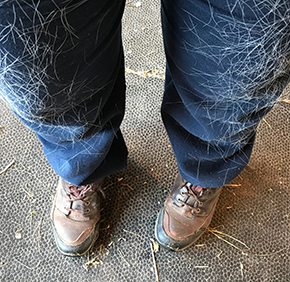
Grooming Tip: Before you begin grooming, discard any fleece jacket or fabrics that you are wearing that will attract dirt and hair before you start. A plastic apron such as dog groomers use, is a great aid in keeping you clean.
If you are up for doing your makeover the old-fashioned way using the grooming kit, here are some valuable tips.
Grooming provides great bonding time with an activity the horse enjoys, and gives an opportunity to examine the horse for wounds, scratches or lumps and bumps. Minor abrasions can be treated with a wound care or skin care product. It is important to determine if the issue is bacterial/fungal and choose a treatment that has efficacy for the particular issue.
The horse’s skin/coat is a valuable resource in determining his health. While regular grooming will bring oils to the coat to make a shine, remember the only true way to resolve a dull coat is by good nutrition including supplements and good horse worming practices.
Grooming Tip: Retire tired old brushes, dirty brushes and brushes that simply don’t fit your hand. These will all make your grooming job more arduous and less effective.
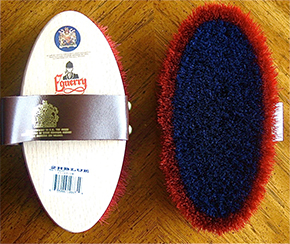 6.5 to 7 inch horse brushes suit most women, 8 inch brushes are designed for the larger handed woman or man. Face brushes are smaller and softer to allow more access to the nooks and crannies of the face of the horse.
6.5 to 7 inch horse brushes suit most women, 8 inch brushes are designed for the larger handed woman or man. Face brushes are smaller and softer to allow more access to the nooks and crannies of the face of the horse.
Pick out the hooves, using the hoof pick pointing toward the toe as you pick. Check the hoof for any sign of thrush and treat as needed.
To remove mud on the horse’s coat, let any mud dry and then vigorously curry comb in a circular motion to loosen the scurf and mud. Work softly over bony prominences and let your horse indicate how hard he likes you to work. A soft jelly curry can be used on the legs over the cannon bones.
Use a mud brush made of tough union fiber to remove stubborn patches of mud effectively and with minimum effort.
Brush your horse over with a dandy brush. Union Tampico bristles work best to gather scurf and dirt. Use a flicking motion to work deep. Start at the neck and work toward the back of the horse and then work down. Do not use a regular curry comb,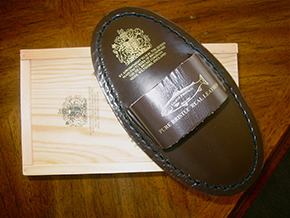 mud brush or dandy brush on your horse’s face, as these are too harsh for use in these areas.
mud brush or dandy brush on your horse’s face, as these are too harsh for use in these areas.
Follow this with long strokes with a body brush over the entire body of horse. Regularly clean the brush on the curry comb as you progress.
Then use a soft horsehair brush over the coat to help bring up the oily shine.
To clean the horse’s face, use a damp clean towel to wipe the eyes and then the muzzle. Then brush the face with a soft brush.
Trim the ear hairs with scissors or clippers. Hold the ear folded together and just trim off the excess longer hairs. Leave hair inside the ear to protect your horse from bug bites.
The hair of the horse, the mane and tail, require special attention and patience to clean properly. Use a detangler before combing them out with a large toothed mane/tail comb.
Work carefully with the tail from the bottom up and take just a few strands at a time until all have been completed. You can use your fingers instead of a comb. A horse’s tail takes a long time to grow so don’t use human hairbrushes or yank on the horse’s tail or it will break the hair. When finished spray the tail again with a shine/detangler (preferably one without silicone as an ingredient as it dries the hair) to protect the hair from dirt and to keep hair in peak condition.
Grooming Tip: A good way to stimulate tail hair growth is a daily dandy brush on dock of the tail. This will stimulate blood circulation.
The dock area of the horse should also be cleaned using an old damp towel (not the same one you use on the eyes and face).
The mane should be carefully combed out. If the mane will not lay flat you can use a warm damp towel over it to settle it to one side. If the mane is excessively long you can pull it using the mane comb.
Grooming Tip: If you pull the mane do it a bit at a time each day when the horse is warm and his pores are open. If your horse dislikes mane pulling try thinning scissors.
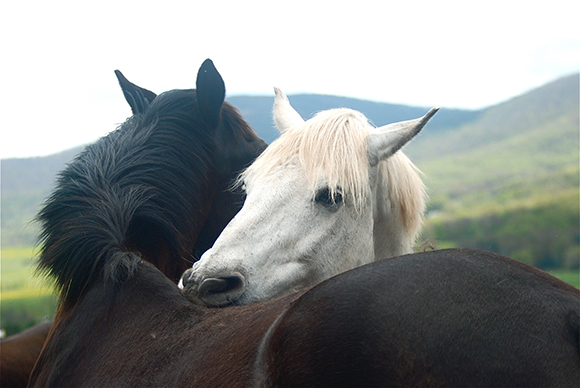
Keep Your Horse Clean
Immediately your have finished bathing and grooming your horse, it is prudent to apply a conditioner and detangler to maintain the beautiful appearance you have worked so hard to achieve. A spray with multiple benefits, of not just conditioning and detangling, but also one that adds shine will probably contain silicone. Products that omit silicone simply don’t do as good a job at detangling and coating the hair. Not all silicones are created equal, and some are more damaging and drying to the horse’s skin and coat than others.
For healthiest results use a product that is made from organic silicone rather than inorganic silicone. While organic silicones are more expensive than their inorganic counterparts, the use of these higher quality silicones significantly reduces their drying effect and the hair will still be protected from breakage, tangling and staining. Look for products that contain high quality ingredients with the optimal neutral pH in a scientific manner, especially where silicone is included because lesser quality silicones result in less shine of the coat and dry the overall skin and hair of the horse.
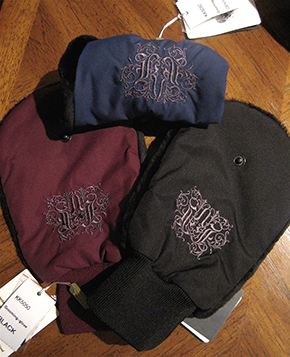 Take a sheepskin mit or a towel and spray on a detangler product and apply across the coat to add a shine. Avoid the saddle and girth area as these conditioners can make the coat slick and cause tack to move.
Take a sheepskin mit or a towel and spray on a detangler product and apply across the coat to add a shine. Avoid the saddle and girth area as these conditioners can make the coat slick and cause tack to move.
Powder white areas of your horse such as socks and stockings with cornstarch or baby powder to make them super bright and white.
Dress the hooves with hoof oil for added shine. Use a nourishing oil that will maintain ideal moisture balance in wet and dry conditions. Avoid products that contain pine oil as this ingredient can be harsh on hooves.
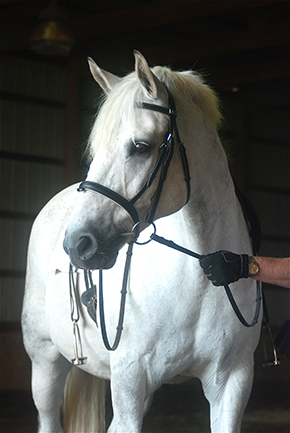 Well done! Dress him in a stable or turnout sheet to keep him clean and don’t forget to give him a healthy treat as a reward. For turnout use a light sheet on your horse. It will not only protect your horse from UV light damage to the coat, and from pesky flies and bugs, it will also provide a barrier to dust and dirt. Manes and tails may be braided to help keep them clean.
Well done! Dress him in a stable or turnout sheet to keep him clean and don’t forget to give him a healthy treat as a reward. For turnout use a light sheet on your horse. It will not only protect your horse from UV light damage to the coat, and from pesky flies and bugs, it will also provide a barrier to dust and dirt. Manes and tails may be braided to help keep them clean.


